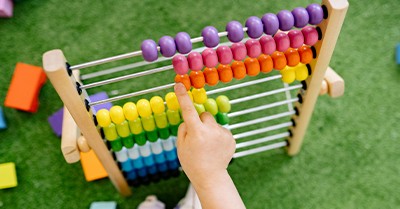Math resources and manipulatives are powerful tools that bring abstract concepts to life for young learners. When incorporated thoughtfully into play-based environments, math manipulatives not only support EYLF outcomes but also nurture confidence, curiosity, and a lifelong love of learning. The following lists 10 Math Resources and Manipulatives for Children.
10 Math Resources and Manipulatives for Children
Dinosaur Sorting Toy Set
- There are 72 dinosaurs of 6 colors, and 12 of each color in 6 dinosaur species. 6 corresponding color bowls, 5 double-sided activity cards, 2 tongs, and a drawstring bag.

Animal Number Counting Game
- The Coogam animal number matching set comes with 10 colorful animals (lion, elephant, giraffe). Each animal was painted with numbers and dots on both sides. It helps to promote hands-on skills, colour sorting skills, and mastery of the primary numbers for early education.

Animals Finger Puppets Treasure with Number Locks
- There are 10 keys and 10 treasure boxes containing 10 animal finger puppets. Each key and the lock on the box are shaped with a number, so kids need to find the right key to open the box and get the treasure inside! This is a fun game for kids to learn numbers and cultivate fine motor skills.

Wooden Counting Peg Board
- Peg board features holes that correspond with the number on each board. This educational material introduces kids to the concept of one-to-one correspondence between name, number, and quantity.

Wooden Sorting & Matching Colour and Shape Set
- The front/back sides of the wooden box are for color/shape sorting; babies and toddlers can put the wooden blocks into the wooden toy by opening the cover, or “coin slots. Its cover has 5 shapes carved into it for kids to learn shape matching.

Geoboard with Rubber Bands
- The wooden geoboard encourages children to explore all types of 2D shapes, figuring out geometric patterns. The challenge cards are designed to have vivid images on the front and abstract geometric shapes on the back. The deliberate juxtaposition helps children develop abstract geometry thinking.

Ice Cream Toy Counting and Color Sorting Set for Toddlers
- The Sotodik ice cream counting and color sorting toy set includes 55 ice cream scoops with 5 colors (green, red, pink, blue, and brown), 10 ice cream cones with numbers, and 10 double-sided learning activity cards.

Math Number Balance Game
- This little elephant balance toy can teach children basic counting and math skills through numbers, little elephants, and game cards. This elephant balance toy set includes 19 elephants, numbers 1-10, 54 game cards, an elephant scale, a base, and 2 weighing pans.

Rainbow Stacking Stones & Activity Cards Set
- These lightweight, colorful stones have immediate visual appeal, plus their warm, smooth surface makes them a wonderfully tactile early math resource. This set includes 20 double-sided activity cards to show colorful designs and ways to stack the pebbles. Use it as a teaching aid to assist child creativity.

Numberblocks Express Train MathLink Cubes Activity Set
- This set includes 21 MathLink Cubes, 5 Numberlings, 30 Train Pieces, 5 Cargo Pieces, 1 Sticker Sheet, 5 Double-sided Activity Cards with 1 Stand, and 1 Activity Guide.

Math and The EYLF
The Early Years Learning Framework (EYLF) beautifully integrates mathematics as part of its holistic vision of children’s learning—especially under Learning Outcome 4: Children are confident and involved learners and Outcome 5: Children are effective communicators.
Here’s how math fits into the EYLF landscape:
Learning Outcome 4: Confident and Involved Learners
Children:
-
Explore mathematical concepts through play, inquiry, and experimentation
-
Use problem-solving, reasoning, and prediction in everyday routines
-
Create and use representations to organise and communicate mathematical ideas
-
Engage in patterning, measuring, sorting, and counting during play-based experiences
Educators support this by:
-
Modelling mathematical language (e.g. “Let’s count how many cups we need”)
-
Embedding math in cooking, sand and water play, and construction
-
Encouraging children to make predictions and test ideas using numbers and patterns
Learning Outcome 5: Effective Communicators
Children:
-
Use math vocabulary to describe size, length, volume, and capacity
-
Engage in math talk during storytelling, dramatic play, and group discussions
-
Begin to symbolise and represent quantities and relationships
Practical Ideas for Embedding Math
-
Loose parts play: Sorting by size, shape, or color
-
Storytime: Ask questions like “How many bears are in the cave?” or “What comes next in the pattern?”
-
Outdoor play: Measure puddles, compare leaf sizes, or count steps
-
Routine moments: Set the table (“How many plates do we need?”), pack away (“Let’s sort the blocks by shape”).
Further Reading
Teaching Math Through Play
Numeracy Activities For Children In Early Childhood
Numeracy Indicators In The Early Years
Children's Learning Through Numeracy
